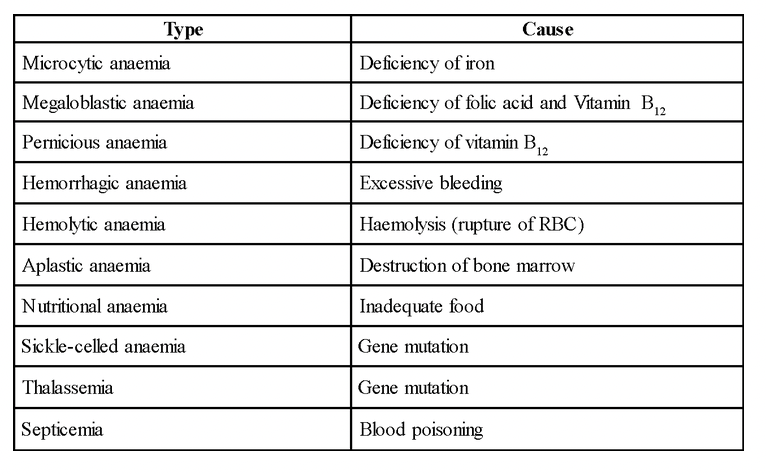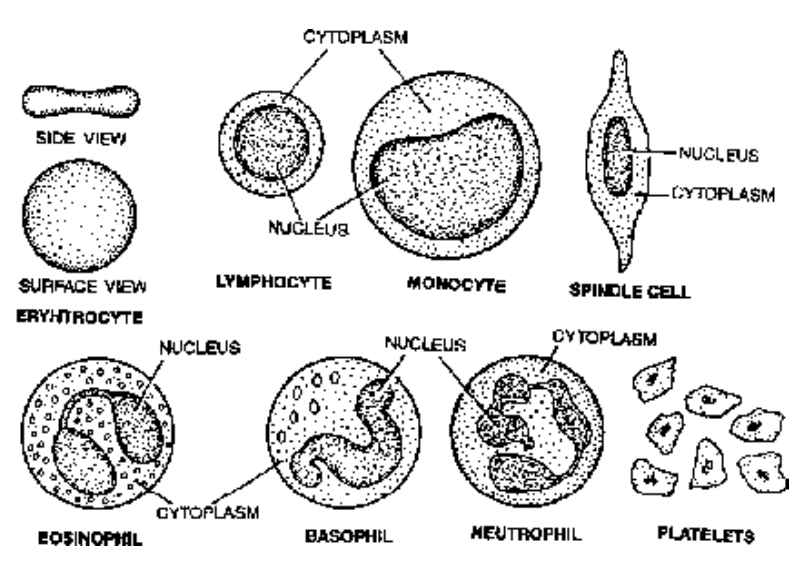Erythrocytes/RBC's
Animal Tissues of Class 11
- Amphibian RBCs are the largest among vertebrates. Amphiuma and proteus have largest RBCs about 80 µm in diameter.
- RBC’s of frog are oval, biconvex and nucleated.
- The musk deer has the smallest RBC of 2.5 µm in diameter.
- RBCs of mammals are round, biconcave and non-nucleated and smallest in entire animal kingdom.
- The absence of nucleus in RBC of mammals increases the respiratory efficiency of RBC. Concave surface of mammalian RBC increases its surface area.
- The cytoplasmic organelles like mitochondria, Golgi bodies, centrosomes, ribosomes etc. are absent in mammalian RBC, this provides enough space for accomodating haemoglobin.
- Camel and Llama has oval and non-nucleated RBCs (other mammals have circular disc-like non-nucleated RBC).
- The normal erythrocyte count in females is slightly lower as compared to males.
- Women - 4.5 to 5 million per cubic mm of blood.
- Men - 5 to 5.5 million per cubic mm of blood.
- The number of RBCs can be counted by using haemocytometer,
- Haemotocrit value is estimated using Wintrobe tube.
- Life span of RBC is about 120 days in man whereas the life span of frog’s RBC is 100 days.
- RBCs are soft and flexible. They can withstand much bending, squeezing and deformation as they pass through narrow capillaries.
- Rouleaux formation occurs by stacking of RBCs like a pile of coins. This adherence is due to surface tension.
- Crenation is shrivelling of RBCs due to concentration of plasma.
- Haemolysis is the outward passage of Hb from the corpuscle due to injury of plasma membrane.
- Agglutination is the clumping of corpuscles induced by various agents like salt solutions, glucose solution and antibodies.
- Hb constitutes about 33% of RBCs. About 280 million molecules of Hb are present per erythrocyte.
- Haemoglobin is a conjugated protein, composed of protein called globin and an iron-porphyrin complex called heme. Oxygenated Hb is bright red and deoxygenated Hb is dark red.
- 100 ml of blood contains about 15g of hemoglobin.
- An adult whose blood contains less than 12g of hemoglobin per 100 cc of blood is said to be anaemic.
Types of Anaemia

- Large amount of reduced hemoglobin in the arterial blood results in a condition called cyanosis, in which nails, lips and mucous membranes become blue in colour.
- Polycythemia refers to abnormal increase in the number of RBCs.
- People living in hills have more RBCs.
- Old non-functional RBCs are destroyed in the spleen, liver and bone marrow. The most important site of RBCs disposal is spleen, also called their ‘graveyard’.
- Hemoglobin is broken down to bilirubin. Bilirubin is the chief pigment of the bile whereas biliverdin is the oxidation product of bilirubin.
- Spleen is also called “blood bank”.
- Blood is red but no RBCs are found in earthworm, Hb is directly dissolved in plasma.
- Haemocyanin is a copper containing respiratory pigment occurring in arthropods and molluscs. It is much less efficient oxygen carrier than haemoglobin.

Fig. Human blood corpuscles and frog’s spindle cell
- Tissue
- Types of Animal Tissues
- Epithelial Tissue
- Covering and Lining Epithelium
- Glandular Epithelium
- Connective Tissue
- Skeletal Tissues
- Vascular Tissues
- Origin of Blood Cells
- Erythrocytes/RBC's
- Leucocytes/WBC's
- Blood Clotting
- Lymph
- Muscular Tissue
- Nervous Tissue
- Integument
- Exercise 1
- Exercise 2
- Exercise 3
- Exercise 4
- Exercise 5
- Exercise 6









